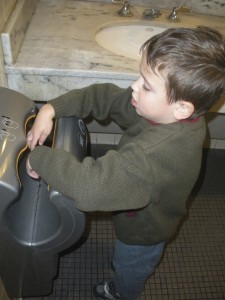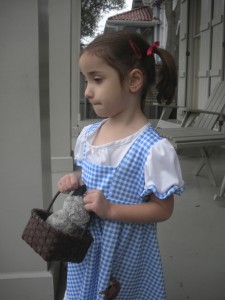
Lynn W. Adams, Ph.D
When my son James was between the ages of two and four, he had a big problem with hand dryers. In most public restrooms the instructions read: 1) Press button, 2) Place hands under nozzle, 3) Rub hands briskly together. Occasionally, some wise guy has added: 4) Wipe hands on pants. James’ responses to hand dryers included: high-decibel screams, pants-wetting, crawling under stall doors, and wedging himself into the backseat like a molly screw. The apex of our hand dryer horrors took place in a roadside McDonald’s the summer James was four. We were returning to New Orleans from a hand-dryer-heavy trip to North Carolina and James was squirming around the booth after picking at his hamburger bun, his little thighs going squeak- squeak on the yellow molded plastic.Instead of gullibly asking if he had to pee-pee, I just said,“Honey, let’s go use the potty.” Our family of four crept toward the promisingly labeled Family Restroom, James clinging catlike to any obstacle in our path.
The closer we got, the louder he shouted. “No, I don’t have to
go! Please, please don’t make me go in there! No hand dryer! I really don’t have to go!” I smiled apologetically at a woman as I peeled his hand off of her purse strap, but she didn’t smile back.
Five minutes later, when we emerged disheveled and unrelieved from the restroom, James now desperately grabbing his crotch, my husband suggested we beat a hasty retreat in case someone had called the authorities. Indeed, all eyes were on us. We dumped our fries and split.
Before I was James’ mother, I worked as a child psychologist. I wanted to ease his suffering at the McDonald’s, but I was also embarrassed that I couldn’t manage my kid. At first, I had tried that old bachelor’s-level technique, avoidance. I avoided public restroom changing tables by performing clandestine diaper changes in the car seat , in the hatchback, behind a bush, and in the stroller. We got by until James was toilet trained. This new accomplishment came with, in addition to Bob the Builder underwear, a need to use public restrooms. There’s only so much pee-peeing in a bush that polite society can tolerate. When I think I’m having a hard time handling things, I just remember the day I helped one child poop very tidily in a bush with the other one strapped to my back. Twice.
This became my public restroom survival kit: a clutch of paper towels, a few blank post-it notes, and some post-it notes that read: “HAND DRYER OUT OF ORDER. PLEASE DO NOT USE.” Our routine went like this: 1) Enter restroom warily; 2) Post out-of-order signs on any and all hand dryers; 3) Place a post-it over the sensor for the automatic flush; 4) Take care of business; 5) Wipe hands on paper towels and collect supplies; 6) Move on. It worked well, but like most irrational fears, this one mushroomed each time we avoided it. At first, it was okay if we didn’t use the hand dryer. Next, no one in the restroom could use it. Eventually, going to a place that might have a hand dryer became too much to bear. I found myself living the pages of my Abnormal Psychology textbook.
A large portion of my psychological training came from proponents of Cognitive-Behavioral Therapy (CBT), a very tidy approach to problem-solving. You identify a problem and perhaps any mistaken assumption associated with it, and then change either what comes before (triggers) or what comes after (rewards or punishments). I first used CBT to train my cat, Walter, to use his scratching post. Instead of whacking him for scratching the sofa, I put a container of treats on top of his post and gave him one every time he scratched it. It was humane and effective. My textbook made the point that a mollusk could be trained to clap its shell on command. Wow, I thought at the time. What can’t CBT do?
Oblivious, I hunkered down. In an attempt to render the scary hand dryer more friendly, we studied up. We printed out pictures of various hand dryer models and posted them around the house. My sweet husband made several hand dryers from boxes, and mounted them in our bathrooms. I came to expect James’ soft, earnest “vvvvvvvvv” sound effect after the flush and the splashing. In Psychology Land, we call this Systematic Desensitization: exposing the child to closer and closer approximations of the feared object to build up tolerance. I stopped short of planting him under the hand dryer in my office building with a pile of M&Ms, but I kept up the campaign from August to November.
One would think that four months of earnest intervention from a psychologist / mother would suffice. When it ended, though, the success was clearly James’ alone. One day, James had to go to the hospital for a medical test. On the way there in the car, we talked about his reward. I had some suggestions: ice cream, a smoothie, the playground, the vacuum cleaner aisle at Lowe’s, the guitar store, a nearby construction site. James looked out the window for such a long time that I’d given up hope of an answer.
As we pulled into a parking space he said, still looking out the window,“No, Mommy, I think I’d like to go to the grocery store and use the hand dryer.”
About the Author: Lynn Adams lives in New Orleans with her husband, son, and daughter. After studying at the Yale Child Study Center and the University of North Carolina at Chapel Hill TEACCH program, she worked as a child psychologist specializing in Autism Spectrum Disorders. Being part-time psychologist, part-time homemaker seemed like the best of both worlds. It wasn’t, and now she is a full-time mom. She is a co-author of Autism: Understanding the Disorder and Understanding Asperger Syndrome and High Functioning Autism.
